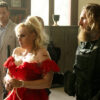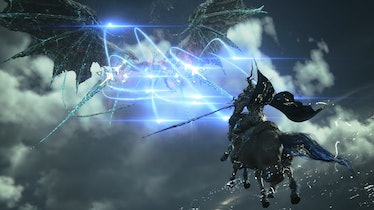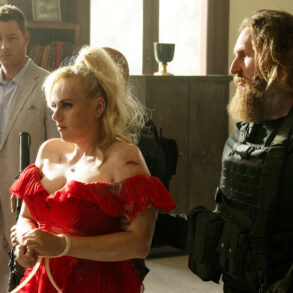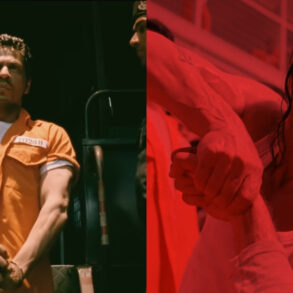Every Eikon battle in Final Fantasy XVI feels like the final boss of any other game.
These over-the-top baddies are the peaks of FFXVI’s roller-coaster experience, with captivating action and unique mechanics that serve a vital narrative purpose. Eikon battles see key characters take on the supernatural abilities — and enormous size — of godlike elemental monsters. But the stakes of these clashes are undeniably human. Romantic betrayals, rivalries between brothers, and good old-fashioned revenge erupt into titanic slugfests that lay waste to entire cities.
FFXVI’s development team has already talked extensively about how it draws from both Game of Thrones and the God of Wår series. But for combat director Ryota Suzuki — who also designed the combat of Devil May Cry V — another iconic franchise helped to inspire these crucial storytelling moments.
“The fact that ‘Godzilla: King of the Monsters’ came out in Japan in the midst of the production of Eikon battles, and that I personally consider it a masterpiece, may have influenced the current Eikon battles,” Suzuki tells Inverse.
Eikon battles serve as the climaxes of both narrative and gameplay in FFXVI, efficiently linking the two together for unforgettable moments/
Square Enix
It’s clear to see the Kaiju inspiration in FFXVI from the designs of the Eikons alone. Bahamut bears a striking resemblance to King Ghidorah, and Clive transforming from a human into the hulking form of Ifrit feels right out of a Tokusatsu film.
While many games reuse some mechanics or enemy designs in their boss fights, each Eikon battle in FFXVI is entirely unique. One feels like a wrestling match between two titans, while another is similar to an on-rails shooter. Though they were easily the most complex element of the game’s development, Suzuki says the team was able to stay close to its initial vision of these climactic showdowns. But it took a whole lot of time.
“Once we went beyond the prototype of the Garuda battle, there weren’t many drastic changes that took place during development. The Eikon battles are so large-scale that 10 months to a year are allotted for the creation of just one piece of content,” he explains. “There were times when we cut some phases or elements as we moved forward in production. However, we were confident that even without these aspects, the game experience would be rich enough, and we made the decision to cut certain things in consideration of development man-hours and playtime.”
Suzuki says the early-game battle against Typhon was almost on the chopping block, due to time constraints. But during a discussion led by producer Naoki Yoshida, the team agreed “the actual experience of controlling Ifrit in a scene where Clive maintains his self for the first time while becoming Ifrit is absolutely necessary.”
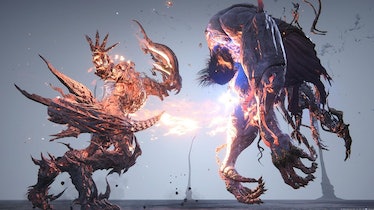



Typhon was a pivotal moment for Clive, as it’s the first time he fully controls Ifrit, which is why the team wanted to keep it in.
Square Enix
Refining the controls and moveset for Ifrit was a massive undertaking, partly to ensure that controlling Clive’s Eikon would feel “heavy” compared to controlling the man himself, while still feeling like a natural extension of the character’s skills. By doing so, the team hoped to keep players feeling prepared for any challenge, even Eikon battle introduces its own unique mechanics like running up the massive stone tentacles of Titan.
With this goal in mind, Suzuki and the development team focused their attention on three specific features for Ifrit; attack actions, movement, and evasive actions. In order to get that feeling just right, each part of Ifrit’s moveset was continuously refined throughout development, with a mind-boggling attention to detail.
“The first step was to determine which part of each action should convey a sense of weight,” Suzuki tells Inverse. “We then made detailed adjustments that revolved around Clive, such as adding a frame before the player can start moving again after an attack or evasion, or adding a frame between the attack decision and the Fireball Burst input. Even if the weight felt good, if the controls were not exhilarating, we would redo it. Conversely, even if the controls felt good, if it didn’t feel heavy enough, we would redo it.”
All of FFXVI’s Eikon battles marry unique gameplay mechanics with sky-high stakes. About a third of the way through the story, Hugo Kupka (Titan’s Dominant) attacks the hideout that Clive calls home. This culminates in a massive, Industrial Rock-infused brawl pitting Ifrit against Titan, filled with all the catharsis of Clive’s revenge.
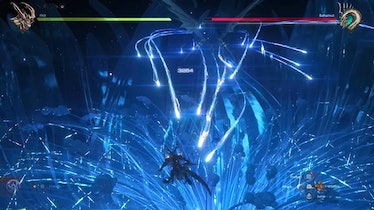



Despite the scale and intensity of Eikon battles, Suzuki and the gameplay to still feel the same as controlling Clive.
Square Enix
But perhaps the most interesting Eikon fight of all is actually the final one, in which Ifrit challenges Barnabas (Odin’s Dominant). First, the two men have a one-on-one duel, without fully transforming into their kaiju forms. Suzuki says this is a vitally important moment for Clive, in that it illustrates how much he’s overcome.
“We designed it to present more of a challenge than other boss battles, and I think that the player would feel this more strongly, the higher the difficulty level. During development, we referred to it not as the Odin fight, but as the semi-primed Barnabas battle,” explains Suzuki. (“Semi-primed” is an FFXVI term that refers to a Dominant using their Eikonic powers for enhanced strength while retaining their human form.)
“It was developed not only as a stoic battle against a strong enemy, but also to incorporate story elements, such as priming into an Eikon and Barnabas regaining his sense of self, thus making it a culmination of the Dominant battles,” Suzuki says.
These high-stakes, high-spectacle clashes have a lot in common with Square Enix’s long-running (and enormously popular) MMO, Final Fantasy XIV. That’s no coincidence, seeing that both games have been helmed by Naoki Yoshida. But according to Suzuki, the development team didn’t set out to create “XIV-style boss battles,” the style between the two games just matched up naturally.
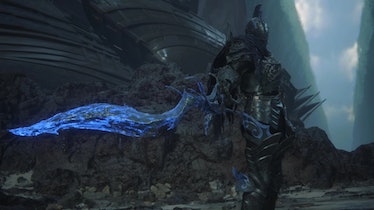



The Barnabas fight is an important moment for Clive reclaiming his humanity and overcoming his biggest obstacle yet.
Square Enix
“We considered XIV players to be one of the core player groups for XVI, so elements that make you grin when playing XIV were incorporated in various places to add a touch of fun,” he says. “These things were not discussed among the team as a whole, but rather each section and each staff member included them of their own accord.”
It’s hard to see how future Final Fantasy titles, or even other action games, won’t draw some inspiration from what’s been done with the Eikons. Even Suzuki himself has already toyed with the idea of seeing a game that dives even deeper into these kinds of massive battles.
“I like the fact that it’s my own two hands controlling the power and harnessing something that resembles Japanese monster movies/Tokusatsu films,” he adds. “It would be interesting to make a game that specializes in this sort of all-out monster experience.”
Final Fantasy XVI is available now on PlayStation 5.
This post was originally published on this site be sure to check out more of their content.

